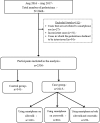Pedestrian smartphone overuse and inattentional blindness: an observational study in Taipei, Taiwan
- PMID: 30595132
- PMCID: PMC6311895
- DOI: 10.1186/s12889-018-6163-5
Pedestrian smartphone overuse and inattentional blindness: an observational study in Taipei, Taiwan
Abstract
Background: Smartphone addiction has become a crucial social issue. Past studies have indicated that phone use such as talking or texting while walking constitutes a dual task that may cause pedestrians inattentional blindness and impair their awareness of surroundings.
Methods: This study investigated the influence of various smartphone tasks (calling, music listening, texting, playing games, and web surfing) on the smartphone overuse and inattentional blindness of pedestrians in Taipei, Taiwan. Pedestrian smartphone overuse was observed and recorded via WiFi cameras to determine whether pedestrians were using their smartphones when crossing a street with a signal. After crossing the street, pedestrians were interviewed to obtain additional information regarding demographics, smartphone tasks, data plan, and screen size. Pedestrians were classified into the case (distracted) and control (undistracted) groups. By determining whether pedestrians saw something unusual-a clown walking the opposite direction-and heard the national anthem played by the clown, inattentional blindness and deafness were examined. Pedestrians' situational awareness was assessed by ascertaining whether they remembered how many seconds remained before the crossing signal upon arriving at the curb.
Results: In total, 2556 pedestrians crossed the street and underwent the interview. Smartphone overuse and inattentional deafness were the commonest among music listeners. Playing Pokémon Go gaming was the task most associated with inattentional blindness. Logistic regression models revealed that contributing factors to smartphone overuse and inattentional blindness were a large smartphone screen (≥5 in), unlimited mobile Internet data, and being a student. The interactions of gaming with being a student and with unlimited data were significantly associated with smartphone overuse, inattentional blindness and deafness, and situational awareness.
Conclusions: Listening to music was the smartphone task most associated with pedestrian smartphone overuse and inattentional deafness. Pokémon Go was the most associated task with inattentional blindness and reduced situational awareness.
Keywords: Inattentional blindness; Pedestrian safety; Smartphone gaming; Smartphone overuse.
Conflict of interest statement
Ethics approval and consent to participate
According to the Personal Information Protection Act of Taiwan, permission was not required to install video cameras on public premises, provided that it is for scientific purpose. The interviewers explained the study to the participants in greater detail. Participants were then asked to sign a consent form acknowledging their understanding of the research. All participants consented to participate in the study, provided that no personal information, images, or video footage were revealed. Written consent was obtained from each participant. The study was approved in its entirety by the Institutional Review Board that is affiliated with Taipei Medical University (IRB#:n201510012).
Consent for publication
Neither personal images nor details of individuals are reported within the manuscript. Consent for publication was therefore not requested.
Competing interests
The authors of the present article have no conflicts of interest to declare.
Publisher’s Note
Springer Nature remains neutral with regard to jurisdictional claims in published maps and institutional affiliations.
Figures
Similar articles
-
Training or Battling a Monster of a Location-Based Augmented-Reality Game While Descending Stairs: An Observational Study of Inattentional Blindness and Deafness and Risk-Taking Inclinations.Front Psychol. 2019 Mar 22;10:623. doi: 10.3389/fpsyg.2019.00623. eCollection 2019. Front Psychol. 2019. PMID: 30967818 Free PMC article.
-
Investigation of traffic and safety behavior of pedestrians while texting or web-surfing.Traffic Inj Prev. 2020;21(6):389-394. doi: 10.1080/15389588.2020.1770741. Epub 2020 Jun 5. Traffic Inj Prev. 2020. PMID: 32500788
-
The impact of walking while using a smartphone on pedestrians' awareness of roadside events.Accid Anal Prev. 2017 Apr;101:87-96. doi: 10.1016/j.aap.2017.02.005. Epub 2017 Feb 14. Accid Anal Prev. 2017. PMID: 28208099
-
Plight of the distracted pedestrian: a research synthesis and meta-analysis of mobile phone use on crossing behaviour.Inj Prev. 2020 Apr;26(2):170-176. doi: 10.1136/injuryprev-2019-043426. Epub 2020 Feb 3. Inj Prev. 2020. PMID: 32015086 Review.
-
Effectiveness of interventions for mobile phone distracted pedestrians: A systematic review.J Safety Res. 2023 Feb;84:330-346. doi: 10.1016/j.jsr.2022.11.008. Epub 2022 Nov 23. J Safety Res. 2023. PMID: 36868662
Cited by
-
Media use during adolescence: the recommendations of the Italian Pediatric Society.Ital J Pediatr. 2019 Nov 27;45(1):149. doi: 10.1186/s13052-019-0725-8. Ital J Pediatr. 2019. PMID: 31775828 Free PMC article.
-
Impact of mobile phone use on accidental falls risk in young adult pedestrians.Heliyon. 2023 Aug 7;9(8):e18366. doi: 10.1016/j.heliyon.2023.e18366. eCollection 2023 Aug. Heliyon. 2023. PMID: 37701410 Free PMC article.
-
Smartphones dependency risk analysis using machine-learning predictive models.Sci Rep. 2022 Dec 31;12(1):22649. doi: 10.1038/s41598-022-26336-2. Sci Rep. 2022. PMID: 36587033 Free PMC article.
-
The Influence of Different Auditory Stimuli on Attentiveness and Responsiveness in Road Traffic in Simulated Traffic Situations.Int J Environ Res Public Health. 2020 Dec 10;17(24):9226. doi: 10.3390/ijerph17249226. Int J Environ Res Public Health. 2020. PMID: 33321821 Free PMC article.
-
Factors Influencing the Smartphone Usage Behavior of Pedestrians: Observational Study on "Spanish Smombies".J Med Internet Res. 2020 Aug 14;22(8):e19350. doi: 10.2196/19350. J Med Internet Res. 2020. PMID: 32667896 Free PMC article.
References
-
- van Deursen AJAM, Bolle CL, Hegner SM, Kommers PAM. Modeling habitual and addictive smartphone behavior: the role of smartphone usage types, emotional intelligence, social stress, self-regulation, age, and gender. Comput Hum Behav. 2015;45:411–420. doi: 10.1016/j.chb.2014.12.039. - DOI
Publication types
MeSH terms
Grants and funding
LinkOut - more resources
Full Text Sources
Miscellaneous



